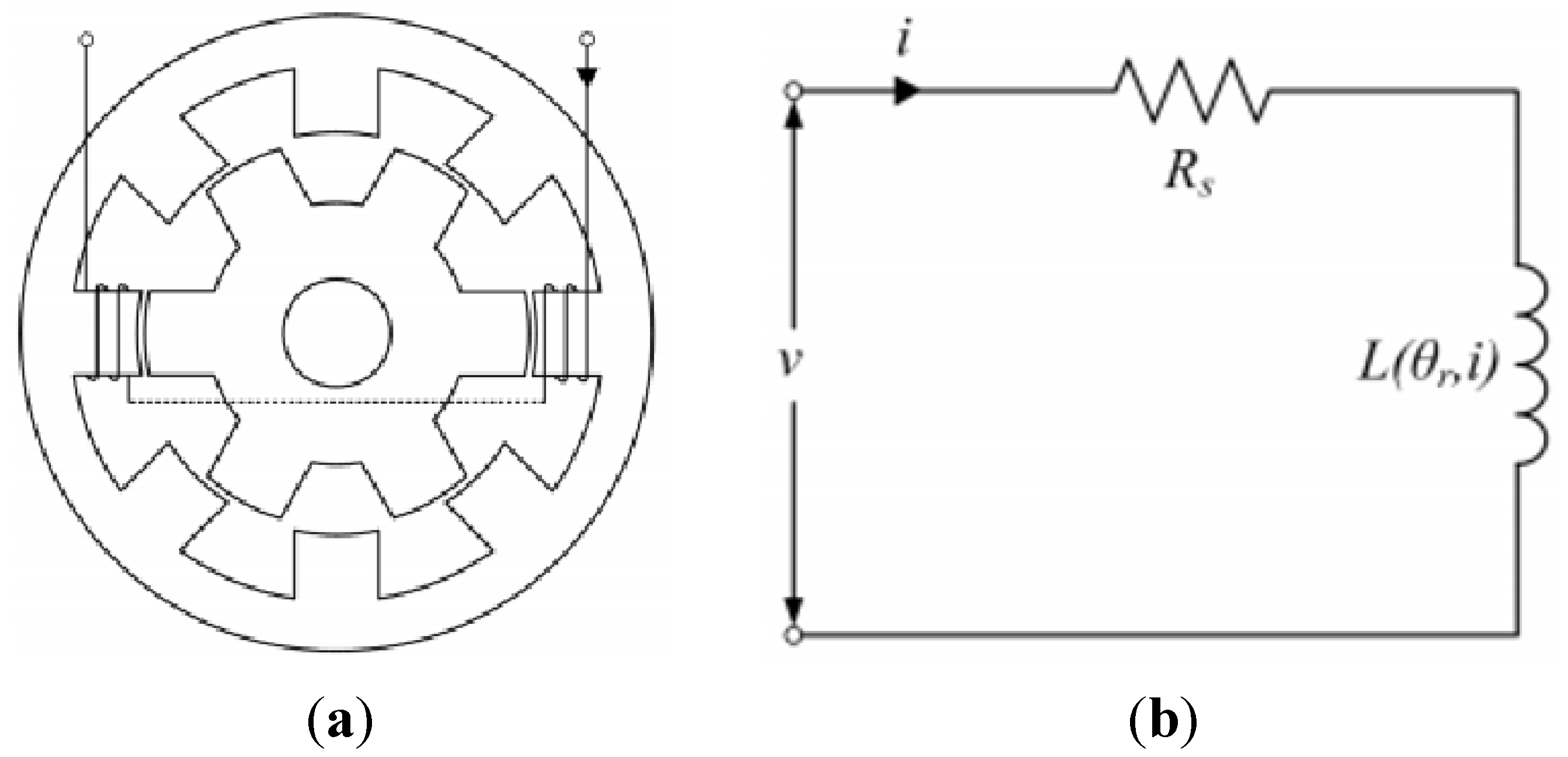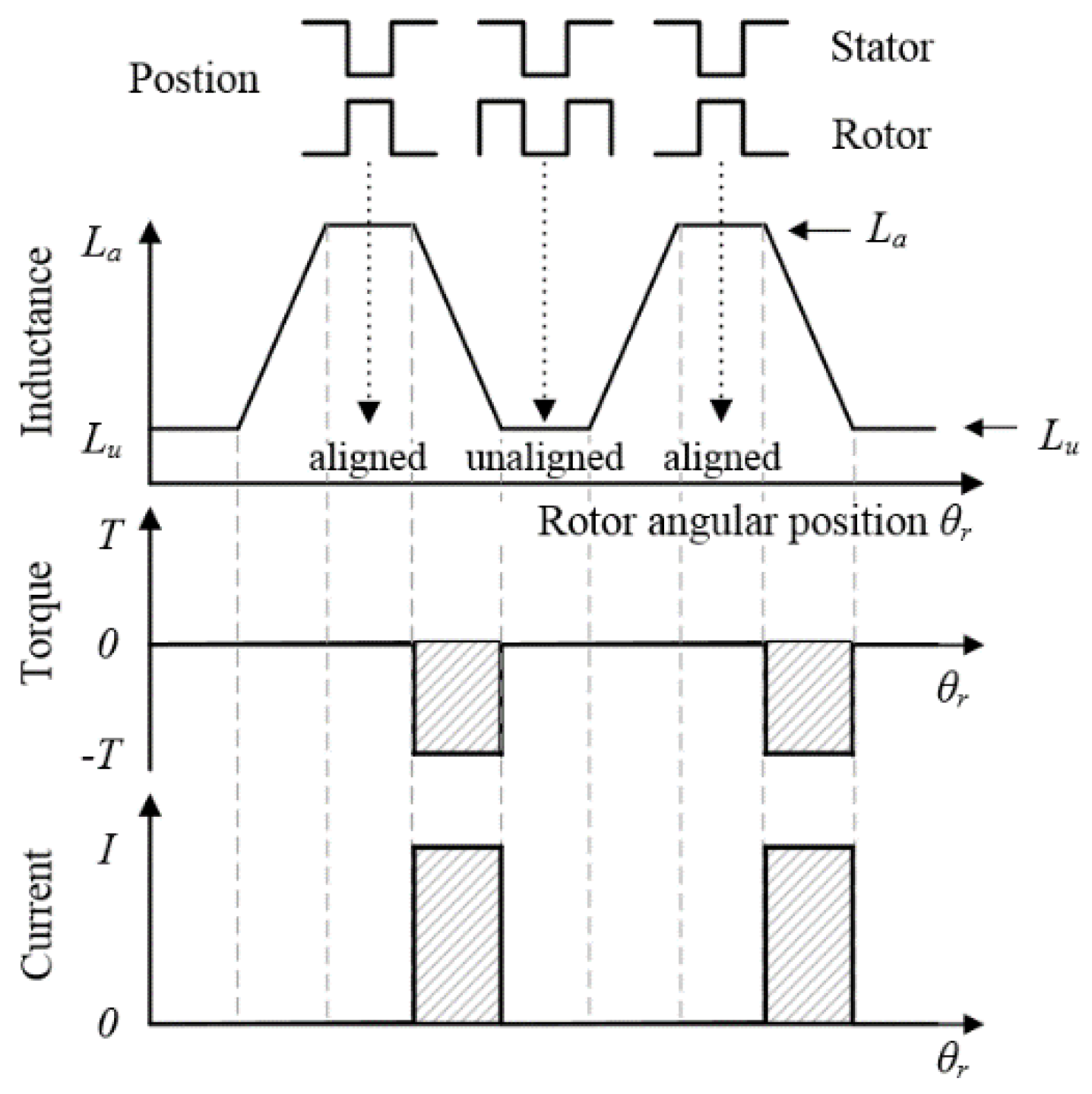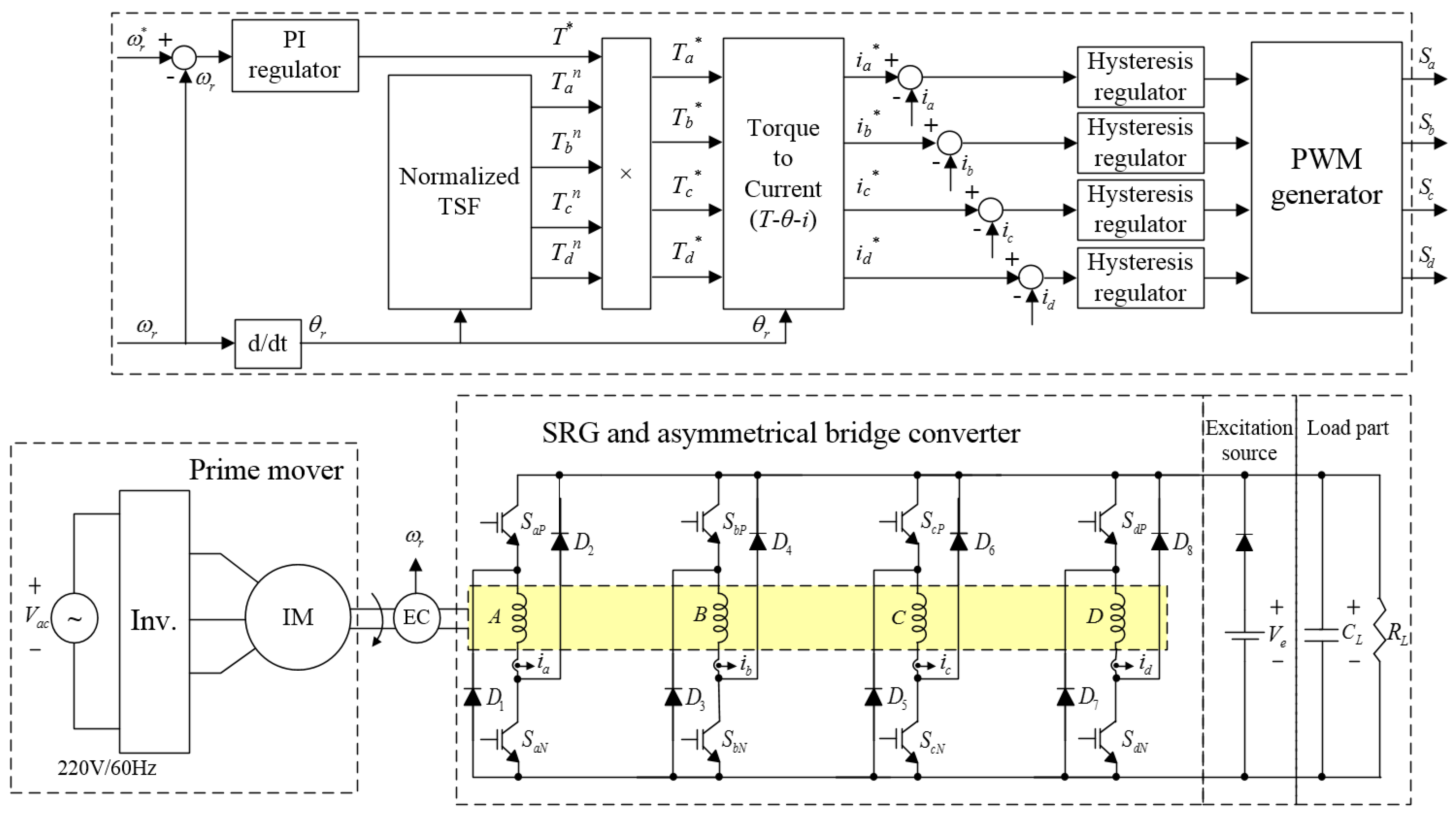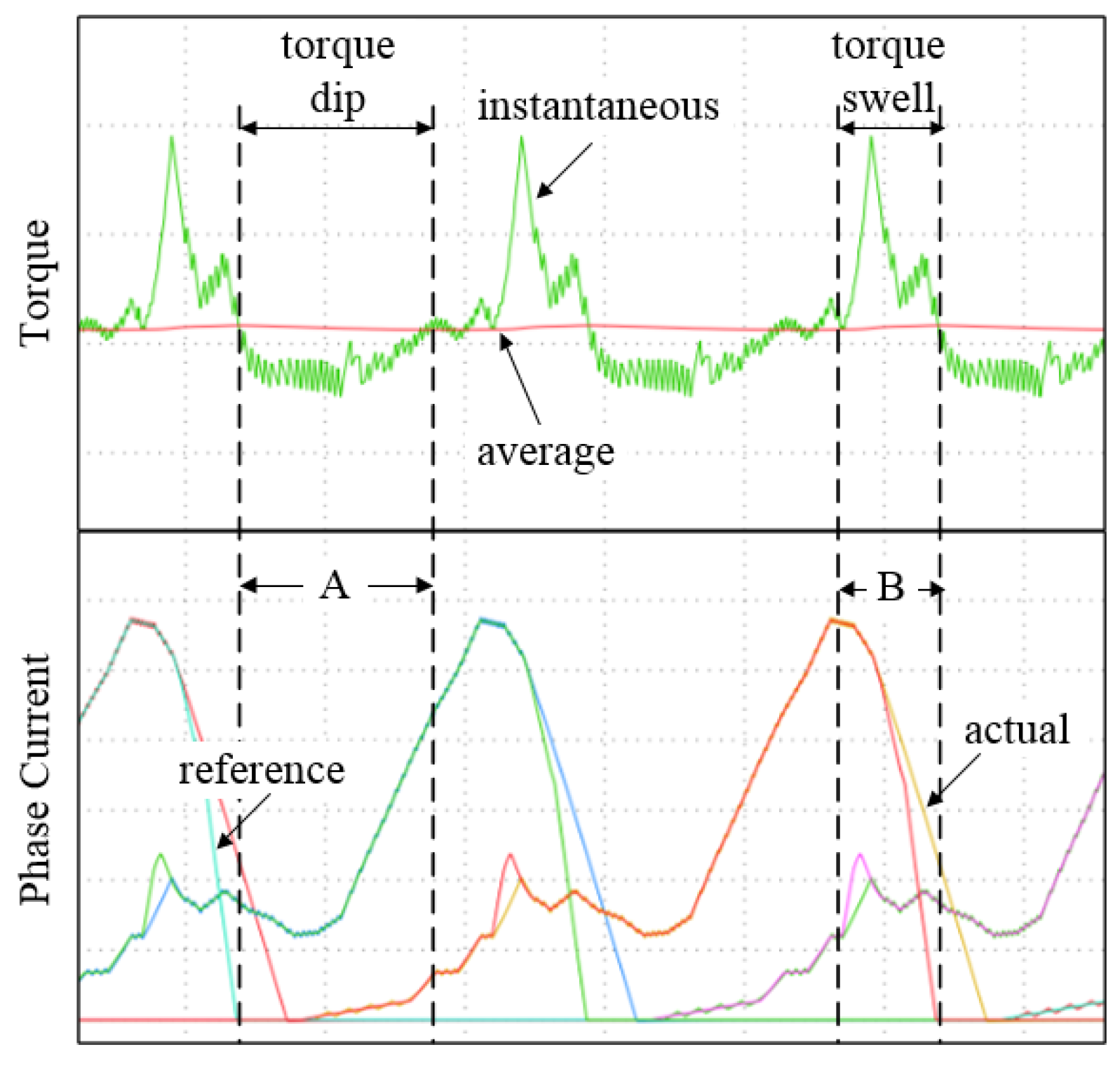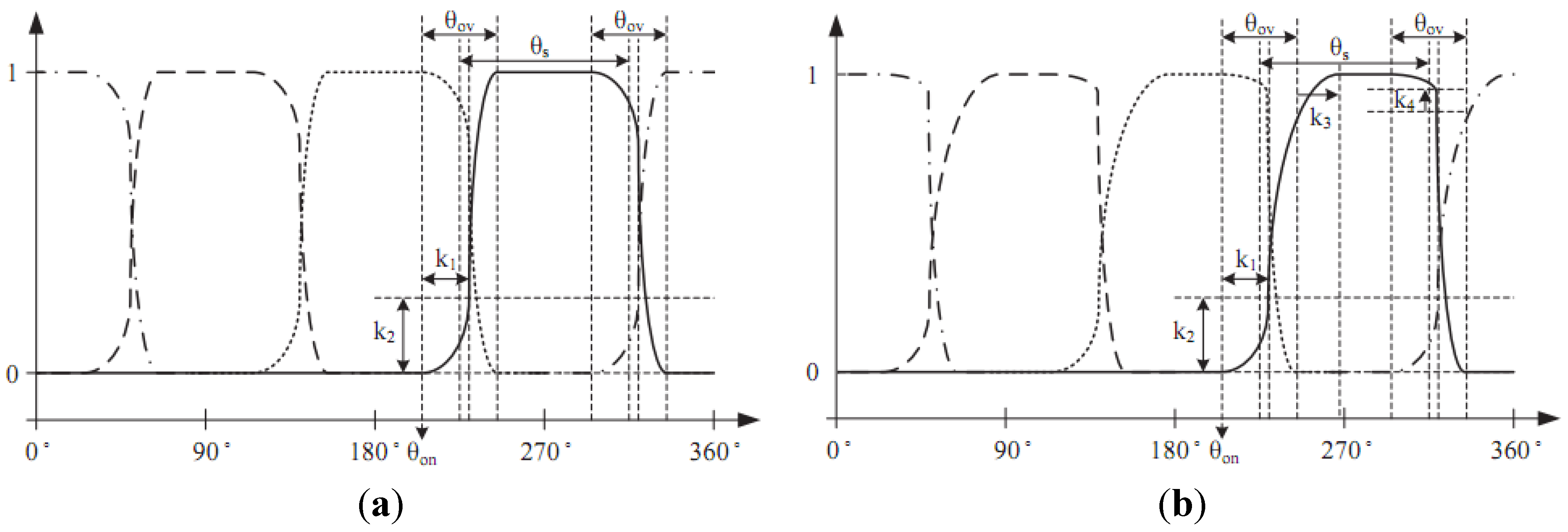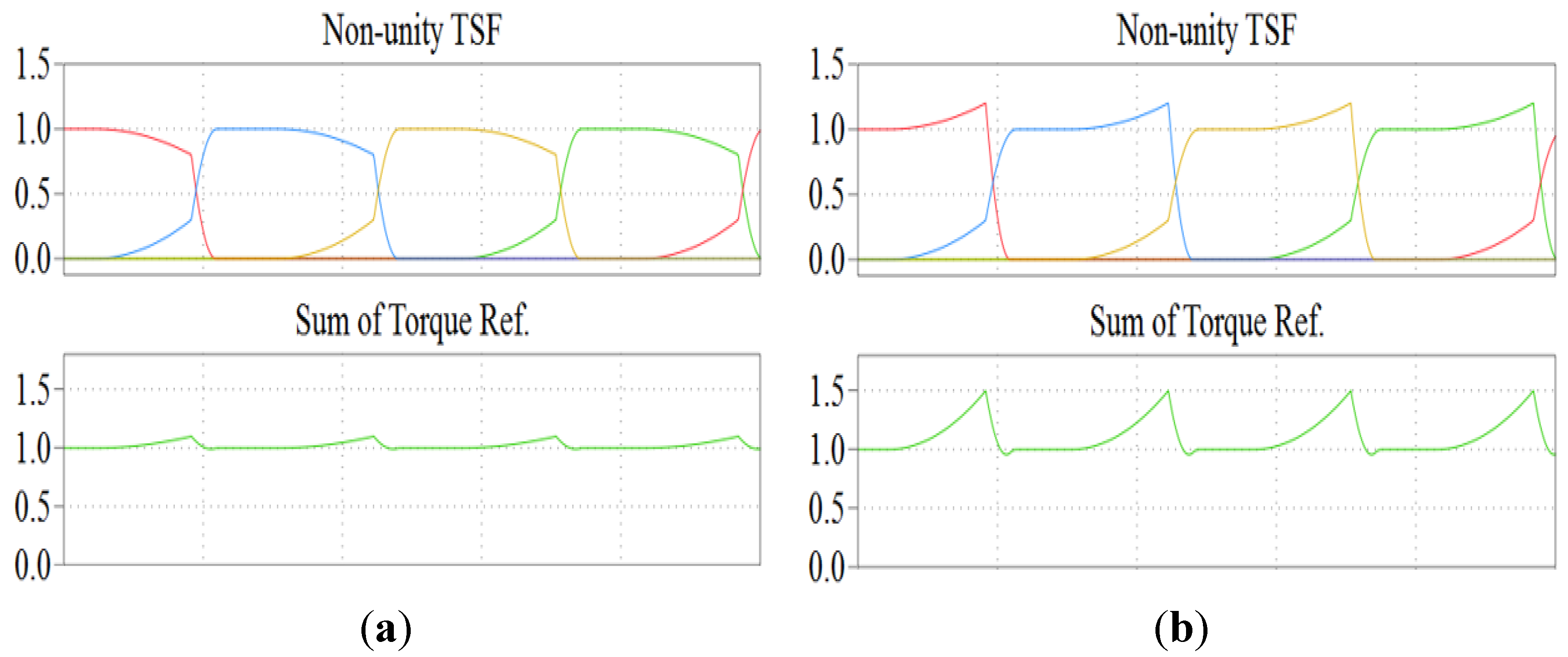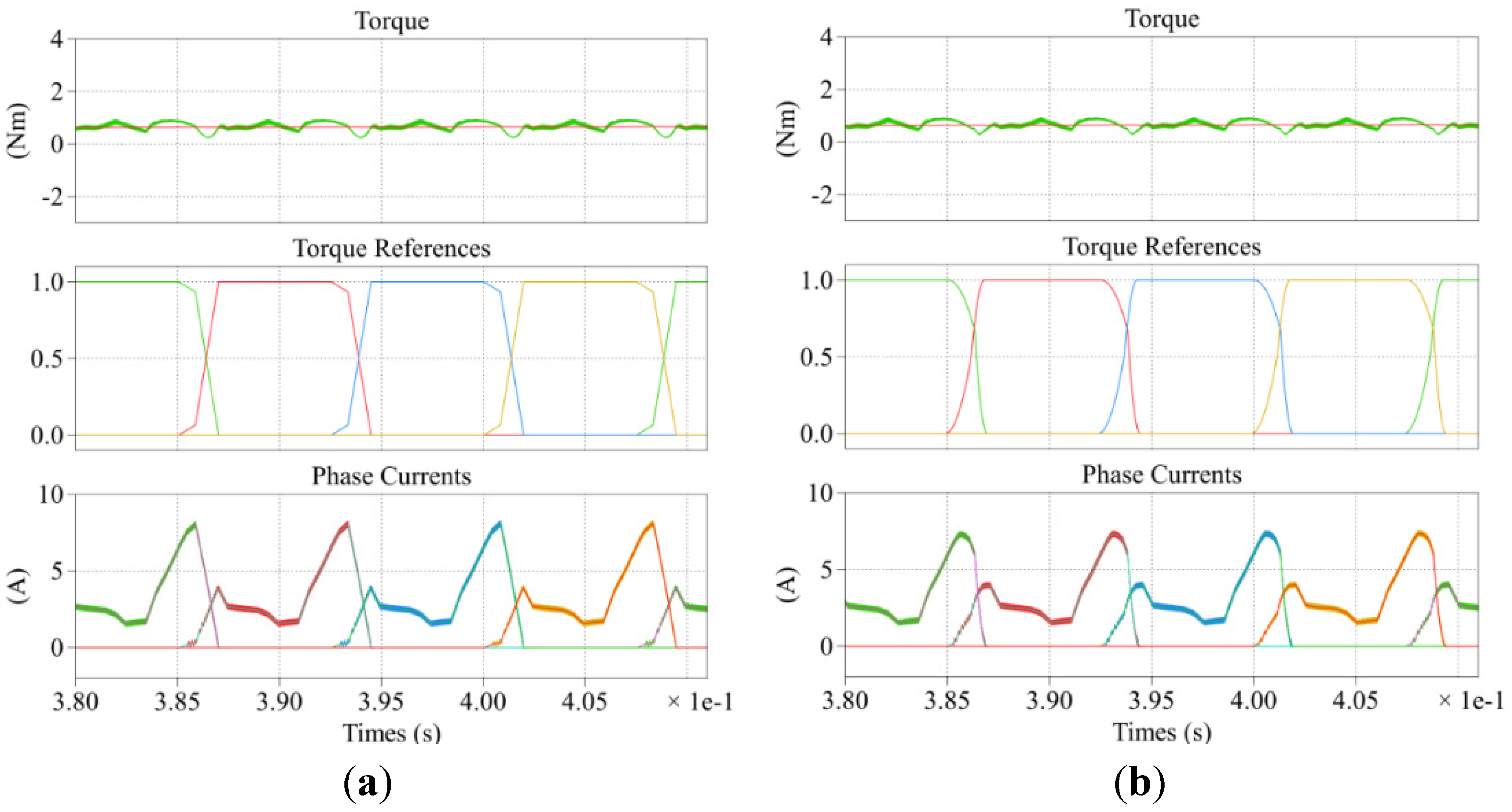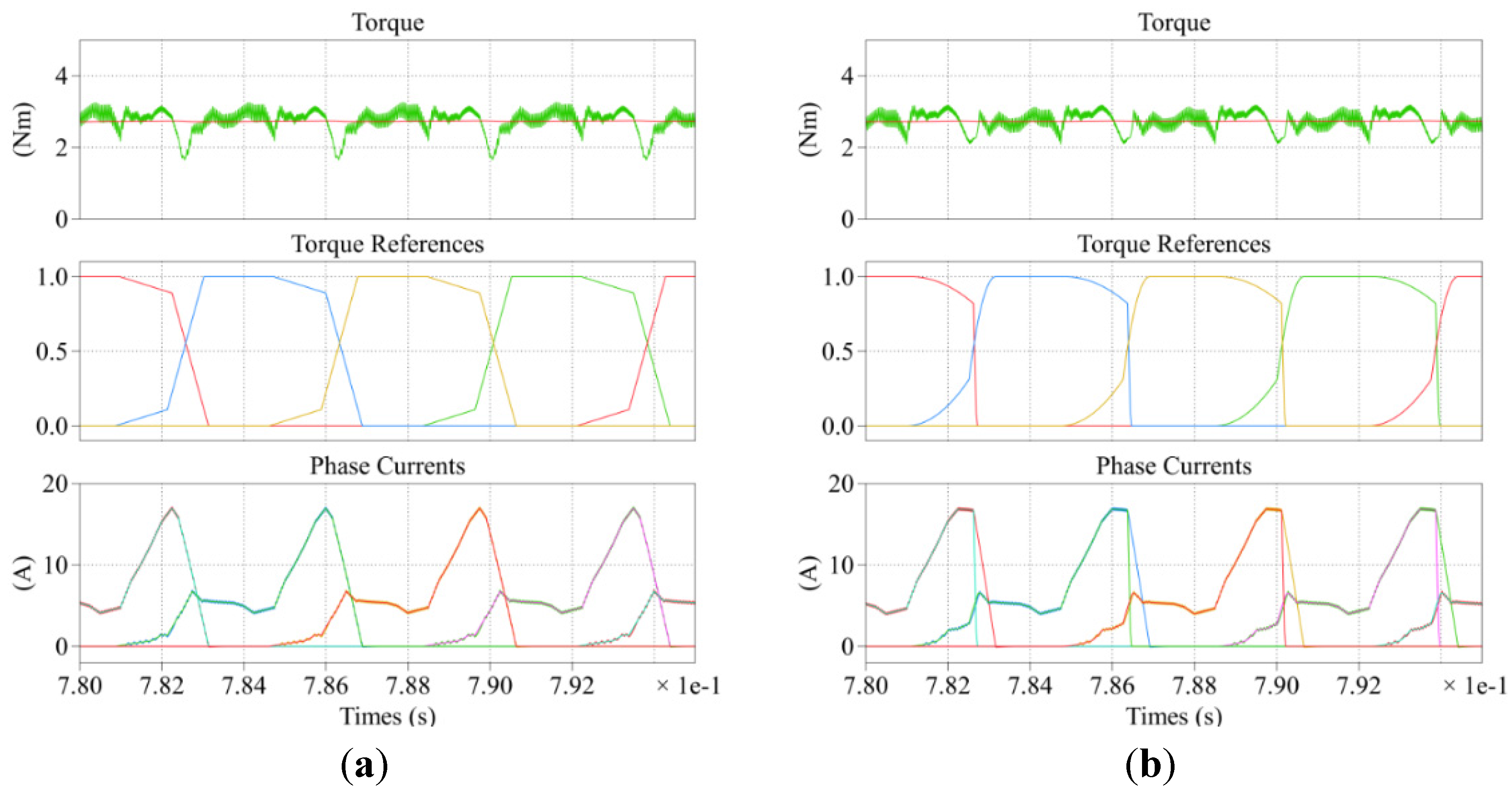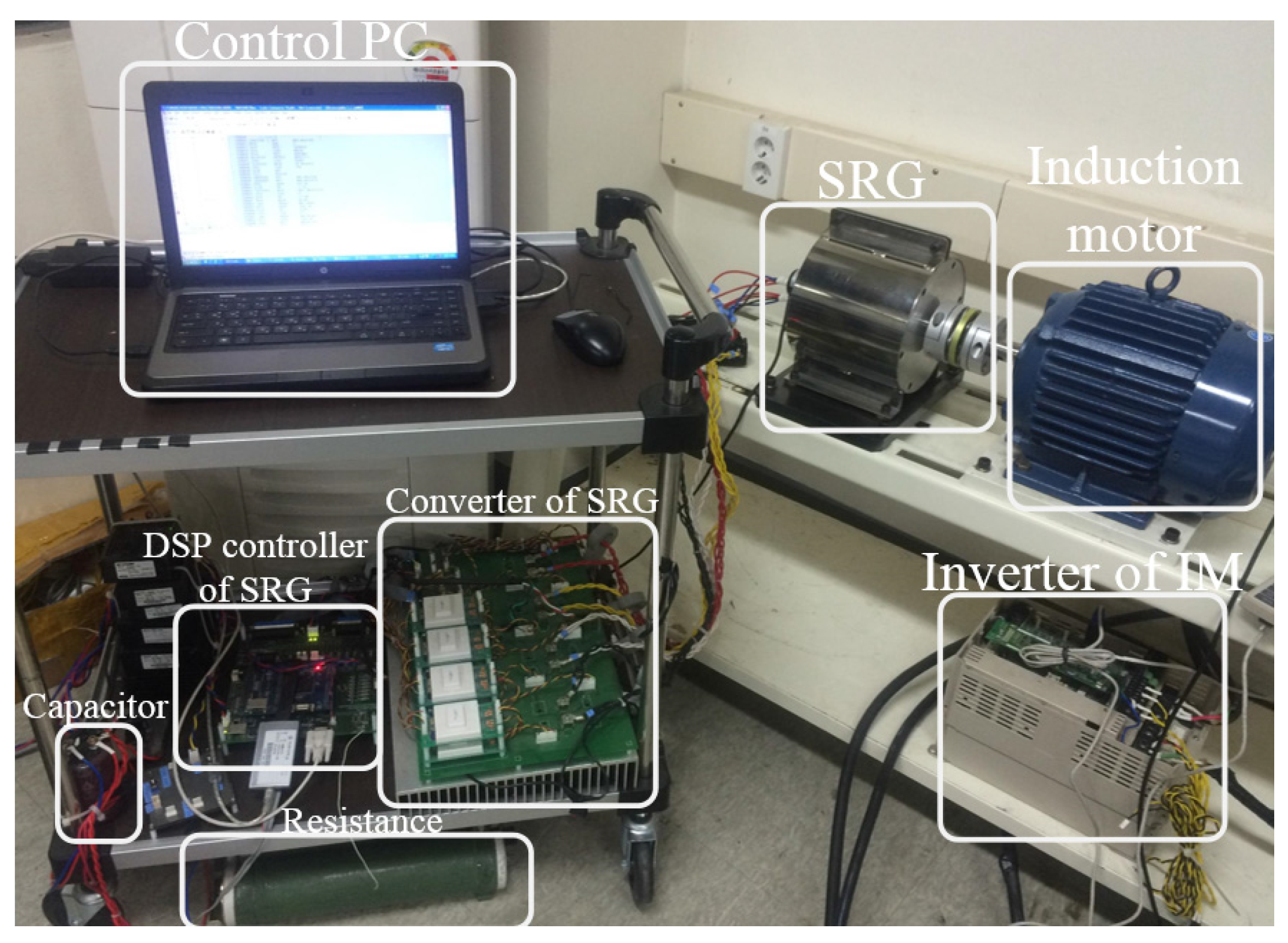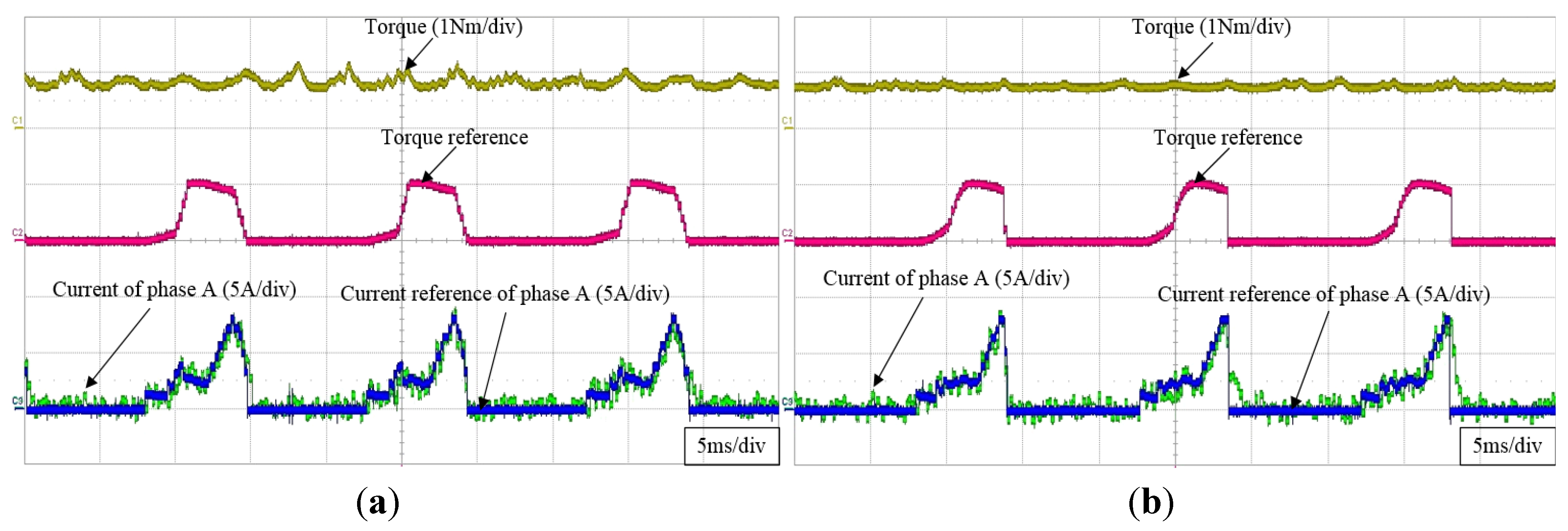2.1. Theoretical Background of the Switched Reluctance Generator Eletromechanics
Before introducing a new torque minimization technique, a brief analysis of the SRG’s electromechanics will be given in this section.
Figure 1a shows the cross-sectional profile of a conventional four phase 8/6-pole SRG and
Figure 1b shows its equivalent circuit of one phase winding. In
Figure 1a, only one phase winding is shown for the sake of simplicity. Both the stator and the rotor of the SRG are usually made of steel laminations. While each salient pole on the stator has a concentrated winding, the rotor does not have any winding or permanent magnet, but a chunk of laminated steel shaped like a gear. This structural feature makes the SRG simple, robust, and low-cost. The equivalent circuit of one phase winding can be simplified with a phase resistance,
Rs, connected to a phase inductance,
L(θ
r,
i) in series. It is worth noting that the inductance is a function of the rotor position, θ
r, and the phase current,
i.
Figure 1.
Four phase 8/6-pole Switched Reluctance Generator (SRG): (a) cross-sectional profile; (b) equivalent circuit of one phase winding.
Figure 1.
Four phase 8/6-pole Switched Reluctance Generator (SRG): (a) cross-sectional profile; (b) equivalent circuit of one phase winding.
The voltage equation of one phase winding of the SRG can be expressed as:
where λ(θ
r,
i) =
L(θ
r,
i)
i is the phase flux linkage. Using the relationship between the fiux linkage, and the inductance and current, this voltage equation can be rewritten as:
where ω
r is the angular speed of the rotor. In the above equation, the terms on the most right-hand side represent the resistive voltage drop, the inductive voltage drop, and the back-electromotive force (back-emf), respectively. It is worth noting that the voltage equation is also a function of the rotor position and the phase current. Furthermore, it is a nonlinear equation where two state variables (here, the angular speed, ω
r, and the phase current,
i) are multiplied together.
The electromagnetic torque equation of the SRG can be derived from the magnetization characteristics of one phase winding, which can be achieved through an experimental test or a finite element analysis (FEA).
Figure 2 shows the magnetization characteristics of the SRG used in this paper. The uppermost line represents the flux linkage when the stator and the rotor are aligned. This line exhibits the high magnetic saturation characteristic of the flux. On the other hand, the lowermost line represents the flux linkage when the stator and the rotor are unaligned completely. This line does not exhibit the saturation characteristic because of a large air gap between the stator and rotor poles.
Figure 2.
Magnetization characteristics of the 1 kW 8/6-pole SRG.
Figure 2.
Magnetization characteristics of the 1 kW 8/6-pole SRG.
The electromagnetic torque can be calculated by finding the partial derivative of the magnetic co-energy with respect to the angular position of the rotor [
14]. The torque equation of the SRG can be expressed as:
This torque is dependent upon the rotor position and the phase current in a nonlinear way because the state variables are multiplied together (here, the phase current, i, is squared). Furthermore, the torque is proportional to the square of the phase current and to the partial derivative of the inductance with respect to the angular position of the rotor.
Figure 3 shows the torque relationship between an idealized inductance profile and a phase current. The idealized inductance profile can be obtained by neglecting the effect of the magnetic saturation. It varies linearly with respect to the overlap between the stator and rotor poles. As can be seen from the figure, the inductance has its maximum value,
La, when the poles of the stator and rotor are fully aligned, whereas it has its minimum value,
Lu, when the poles are completely unaligned. If a constant current is drawn in the phase only during the negative slope of the inductance profile, the negative torque can be generated. Therefore, if each phase produces torque in sequence at proper instants, the SRG can produce continuous unidirectional torque.
Figure 3.
Torque relationship between the idealized inductance profile and the phase current.
Figure 3.
Torque relationship between the idealized inductance profile and the phase current.
2.2. Characteristics of Wind Turbine
The required output power of SRG is considered according to the shaft speed with wind turbine [
15,
16].
The mechanical torque produced by a wind turbine is given by:
where the parameters
,
,
,
,
, and
are, respectively, torque coefficient, air density, blade radius, blade pitch angle, wind velocity, and tip-speed ratio.
Power captured from the wind turbine is obtained as seen in Equation (6) and
is the tip-speed ratio which can be defined as:
where ω
m represents the rotational speed of the blades,
denotes the power coefficient, which is directly determined by
when the blade pitch angle is fixed. It is desired to verify the effectiveness of the proposed torque ripple minimization technique for higher wind speed by considering the power captured from the wind turbine.
2.3. Main Causes of Torque Ripples
There are several main causes of the torque ripples in the SRG: inherent nonlinearity, phase commutation, and current switching. If the effect of the magnetic saturation is not neglected, the inductance profile does not vary linearly with respect to the overlap between the stator and rotor poles anymore. Hence, even if the each phase is controlled to draw a constant current, the produced torque is not constant anymore. This nonlinearity usually causes a torque swell when a single phase is solely in charge of producing the entire toque required. Therefore, the phase current should be shaped according to the nonlinear torque–angle–current (T–θr–i) characteristics of the SRG to produce a constant torque.
Another major cause of the torque ripple is the discrete nature of torque producing mechanism due to the doubly salient structure of the SRG. Unlike traditional three-phase generators such as an IG or a PMSG, the SRG does not utilize a smooth rotating magnetic field. Each phase of the SRG is responsible for producing torque independently using magnetic reluctance force. Therefore, the SRG has a very high torque ripple, usually a torque dip, during the phase commutation period when the torque production is being transferred from the outgoing phase to the incoming phase.
The other cause of the torque ripple is the current switching. The current in each phase should be controlled to track its desired value by switching the power semiconductor switches connected to the phase. As a consequence, these current ripples cause additional torque ripples at the switching frequency. The magnitude of the torque ripple depends on the switching frequency and the operating conditions such as an input voltage, a load torque, and/or an operating speed. If the phase current is controlled by a hysteresis current controller as in this paper, the magnitude of the torque ripple is significantly dependent upon the size of its hysteresis band.
2.4. Traditional Torque Sharing Functions
The TSF controls the instantaneous torque of the individual phases by profiling the phase currents optimally during a phase overlapping period between the outgoing and incoming phases.
Figure 4 shows the overall SRG control system including the TSF method. When the prime mover operates at the different speed, ω
r can be obtained from the encoder of the rotor. The result of speed control produces the total torque required (
T*). The normalized TSF block produces torque references for the individual phases based on the angular position of the rotor. These normalized torque references are multiplied with the total torque required (
T*) so that the actual torque reference for each phase is obtained separately.
Figure 4.
Overall torque control scheme of the Torque Sharing Function (TSF) method.
Figure 4.
Overall torque control scheme of the Torque Sharing Function (TSF) method.
Each torque reference is, then, converted into a current reference through the 2-D lookup table of the torque–angle–current (
T–θ
r–
i) characteristics, which can be directly obtained from the magnetization characteristics of the SRG. To avoid storing large lookup table data, an invertible torque function [
17] can be used instead. Finally, the hysteresis current regulators produce switching signals for the driving power converter based on the reference currents and the measured currents. All switching signals are produced through the PWM block.
According to the torque sharing curve used, the traditional TSFs can be classified as linear or nonlinear TSFs as shown in
Figure 5a,b. The nonlinear TSFs further can be classified into sinusoidal, cubic, and exponential TSFs. By optimizing the turn-on angle, θ
on, and the overlapping angle, θ
ov, the torque ripple can be minimized.
Figure 5.
Typical profiles: (a) linear TSF; (b) nonlinear TSF; (c) asymmetric TSF.
Figure 5.
Typical profiles: (a) linear TSF; (b) nonlinear TSF; (c) asymmetric TSF.
Although these TSFs have been dominantly developed for the motoring operation, they can be directly employed for the generating operation. However, if the unique characteristic of the SRG is taken into account, the performance of the TSF method can be enhanced further. Unlike the motoring mode, each phase of the SRG starts being energized when the stator and the rotor are aligned, and deenergized when they are unaligned. In other words, the phase inductance is at its maximum value when the phase starts conducting a current. This high inductance prevents a current from tracking a reference value accurately, especially when the rate-of-change of the reference current is large. This phase current error, in turn, induces additional torque ripples. In order to solve this problem, an asymmetric TSF that utilizes a piecewise linear curve to lower the rate-of-change of the current reference has been proposed [
9], as shown in
Figure 5c. By introducing two more control parameters (
k1 and
k2), the asymmetric TSF utilizes two different slopes during the phase overlapping period. It is worth noting that the stroke angle, θ
s, is determined according to the number of the phases,
Nph, and the number of the rotor poles,
Nr, as below:
Even though the TSFs have different shapes, they all satisfy a basic requirement as a TSF: the sum of all the normalized phase torque references is always equal to unity. Furthermore, they all assume that the actual current is well controlled to track its reference value. Therefore, the TSF technique is not applicable to the single-pulse voltage mode.
